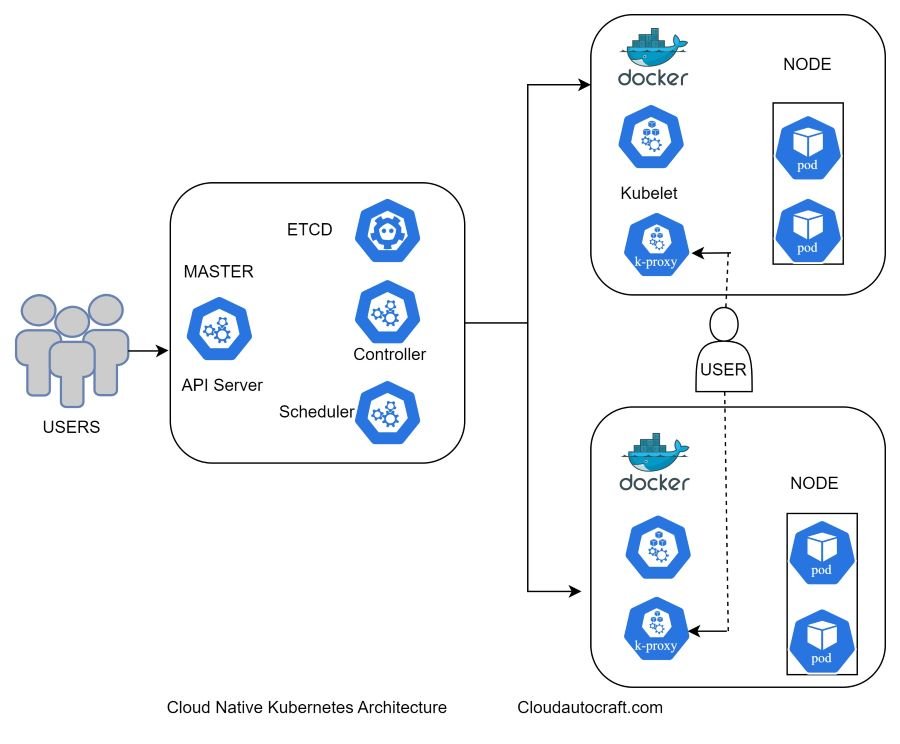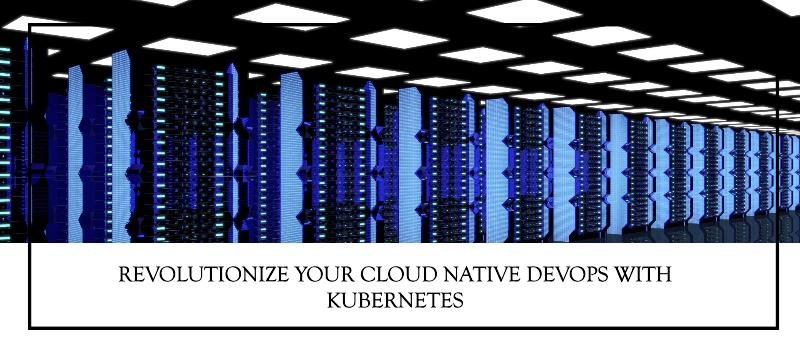Content:
- Introduction
- Understanding the Cloud-Native Paradigm
- Understanding Cloud Native DevOps
- Kubernetes: The Foundation of Cloud Native DevOps
- Embracing the Cloud Native DevOps with Kubernetes Approach
- Setting Up a Cloud Native DevOps with Kubernetes
- Building and Deploying Applications
- Implementing CI/CD Pipelines for Cloud Native DevOps with Kubernetes
- Monitoring and Logging for Cloud Native DevOps with Kubernetes
- Security in Kubernetes
- Maximizing Cloud Native DevOps Benefits with Kubernetes
- Best Practices for Cloud Native DevOps
- Conclusion: Cloud Native DevOps with Kubernetes
- FAQs:
Introduction
In the ever-evolving landscape of technology, the rise of cloud-native development and the power of Kubernetes has revolutionized how we approach software deployment and infrastructure management. As businesses strive to stay ahead of the curve, embracing this dynamic ecosystem has become a strategic necessity. In this blog post, we’ll embark on an exciting journey of exploration to uncover the compelling benefits of implementing Cloud Native DevOps with Kubernetes, empowering you to streamline your workflows and unlock new levels of efficiency.
Understanding the Cloud-Native Paradigm
Let’s dive into the world of cloud-native software development. It’s a game-changer because it leverages the cloud’s unique features, like scalability, flexibility, and resilience. In the same way, organizations can become more agile and responsive. But how does this work? By designing applications that are containerized, loosely coupled, and highly distributable.
As a result, teams can iterate quickly, deploy efficiently, and scale their solutions to seamlessly meet the ever-changing demands of the digital landscape.
In this guide, you’ll find your go-to resource for implementing Cloud Native DevOps with Kubernetes. We’ll begin by covering the basics of Cloud Native DevOps. Then, we’ll set up a Kubernetes environment, deploy applications, and automate workflows. Additionally, we’ll dive into the tools and best practices to help you build and manage scalable, resilient, and efficient applications in the cloud.
Understanding Cloud Native DevOps
Cloud Native DevOps with Kubernetes brings together cloud technologies and DevOps principles to simplify software development and deployment. Moreover, it emphasizes automation, using infrastructure as code, continuous integration and delivery (CI/CD), and microservices architecture. These practices are designed to speed up development cycles, improve application reliability, and boost overall organization efficiency.
Furthermore, By combining cloud-native tools with DevOps, teams can collaborate more effectively and adapt quickly to changes. Hence, This integration fosters innovation and helps maintain a competitive edge in today’s fast-paced landscape.
Kubernetes: The Foundation of Cloud Native DevOps
At the heart of the cloud-native revolution is Kubernetes. Switching to Kubernetes is a game-changer for Cloud Native DevOps. As an open-source container orchestration platform, it automates containerized applications’ deployment, scaling, and management across a cluster of nodes. Consequently, Kubernetes offers a robust, flexible platform for running microservices-based applications.
With Kubernetes, you get high availability, scalability, and fault tolerance, which are essential for modern software development. Therefore, it’s an indispensable tool for building resilient and scalable applications in today’s fast-paced tech landscape.

Embracing the Cloud Native DevOps with Kubernetes Approach
By integrating Cloud Native DevOps with Kubernetes practices, you can unlock a new level of efficiency and agility. Specifically, Kubernetes enables rapid application deployment, seamless scaling, and effortless rollbacks. This empowers your teams to iterate quickly and deliver value to your customers faster.
Furthermore, the platform’s self-healing capabilities and automated load balancing are invaluable. These features ensure your applications remain highly available and resilient, even in unexpected failures or spikes in demand. With Kubernetes, you can maintain smooth operations no matter the challenge.
Setting Up a Cloud Native DevOps with Kubernetes
There are several ways to set up a Kubernetes environment, depending on your needs and preferences. For instance, you can choose to deploy Kubernetes on your infrastructure. Alternatively, you might utilize a managed Kubernetes service from cloud providers like AWS, Azure, or Google Cloud. Another option is to leverage a local development environment using tools like Minikube. Each approach offers unique benefits tailored to different requirements.
- On-premise Kubernetes
- Managed Kubernetes Service
- Local Development Environment
Building and Deploying Applications
Once your Kubernetes environment runs, you can build and deploy your applications. This process involves containerizing your applications with tools like Docker, creating deployment configurations for Kubernetes, and defining service specifications. Afterward, Kubernetes handles the heavy lifting by scheduling containers across nodes, load balancing, and managing the entire application lifecycle. Consequently, this automation allows you to focus on developing and improving your applications without worrying about the underlying infrastructure.
Implementing CI/CD Pipelines for Cloud Native DevOps with Kubernetes
Continuous integration and delivery (CI/CD) pipelines are crucial for automating the build, test, and deployment processes. For example, tools like Jenkins, GitLab CI/CD, and CircleCI can be integrated with Kubernetes to streamline your workflows. Automating these processes can significantly reduce the time and effort required to release software updates. Consequently, this leads to faster deployment cycles and more reliable software releases.
Monitoring and Logging for Cloud Native DevOps with Kubernetes
Monitoring and logging are essential for gaining insights into application performance and identifying potential issues. For instance, tools like Prometheus, Grafana, and the ELK stack can collect metrics, visualize dashboards, and analyze logs. You can proactively identify and address problems by monitoring your applications, ensuring high availability and performance. Ultimately, this proactive approach helps maintain the reliability and efficiency of your applications.
Security in Kubernetes
Security is crucial in any cloud setup. Specifically, Kubernetes offers many security features like network policies, role-based access control (RBAC), and pod security policies. So, it’s essential to have solid security practices in place. This means locking down your Kubernetes cluster, setting up access controls properly, and ensuring you have processes for scanning vulnerabilities and patching any issues. As a result, you can beef up the security of your Kubernetes environment and keep your applications and data safe.
Maximizing Cloud Native DevOps Benefits with Kubernetes
Implementing Cloud Native DevOps with Kubernetes can transform your organization in several key ways:
- Speedier Development Cycles: By automating how you build, test, and deploy, your teams can focus on innovating and getting new features out faster.
- Better Scalability and Availability: With Kubernetes managing things, your applications can scale up or down smoothly as needed, making sure you use resources efficiently and stay available when it counts.
- More Reliable and Resilient: Kubernetes can fix things on its own and handle problems well, making your apps less likely to go down unexpectedly, even when things get rough.
- Boosted Developer Productivity: Since Kubernetes takes care of the challenging parts of the infrastructure, your developers can spend more time writing great code and less time dealing with setup.
- Simpler Operations and Maintenance: Managing your cloud setup becomes easier with Kubernetes, cutting down on the day-to-day work and letting your teams focus on big-picture goals.
Kubernetes helps your organization run smoother, innovate faster, and keep everything reliable and scalable in the cloud
Best Practices for Cloud Native DevOps

| Microservices Architecture | This is all about breaking down your application into more minor, independent services. Think of it as a building with LEGO bricks – each piece does its own thing but fits together perfectly. This approach makes your application more modular, so you can scale parts of it without messing up the whole thing. Plus, if one service has a problem, it doesn’t bring down everything else. |
| Infrastructure as Code | Instead of setting up your servers manually, you write code that defines your whole setup. Consequently, This makes things way more automatic and repeatable. Tools like Terraform and Ansible are like your magic wands here – they turn your code into real servers, networks, and all the other tech stuff you need. |
| Continuous Monitoring and Feedback | It’s like having a detective always watching your application. You set up tools that monitor how your app is doing – like how fast it’s running if there are any errors, and what your users are doing. |
| Collaboration and Communication | Furthermore, This is like teamwork on steroids. In this setup, your development and operations teams work closely together, sharing ideas and ensuring everything runs smoothly. As a result, good communication means fewer misunderstandings and quicker fixes when something goes wrong. Ultimately, it’s all about getting everyone on the same page and working toward the same goals. |
These principles all work together to make your software development and operations more efficient, reliable, and responsive to change.
Conclusion: Cloud Native DevOps with Kubernetes
Embracing Cloud Native DevOps with Kubernetes is like setting sail on a transformative journey for your organization. It’s a path that can boost your agility, scalability, and efficiency. Thus, By tapping into the power of containerization and Kubernetes’ orchestration abilities, you open the door to a new wave of innovation and can speed up how quickly you bring new ideas to market. But remember, success here is all about taking it step by step.
Start by gradually adopting and integrating these technologies into your existing workflows. As a result, you’ll see the benefits unfold, empowering your teams to thrive in today’s fast-paced world of Cloud Native DevOps with Kubernetes development.
Click here to Read more about How to Excel in the Cloud-Native Revolution && Best GitOps Tools for Top Performance
FAQs:
What are the key benefits of Cloud Native DevOps with Kubernetes?
Answer: The main advantages of using Kubernetes are that it really streamlines container management, boosts scalability, and seamlessly integrates with cloud infrastructure. Therefore, this makes it a game-changer for cloud-native DevOps teams.
How does Kubernetes simplify cloud-native app deployment?
Answer: Kubernetes simplifies cloud-native app deployment by automating the setup and scaling of applications. It uses declarative configurations to define how apps should run, handles scaling automatically to meet demand, and ensures apps stay reliable with features like self-healing and rolling updates. Consequently, developers can focus more on coding and less on managing infrastructure, making deployment smoother and more efficient.
What Kubernetes concepts do I need to know for Cloud Native DevOps?
Answer: To succeed in Cloud Native DevOps with Kubernetes, focus on containers for packaging, pods as deployable units, deployments for managing updates, services for stable endpoints, ConfigMaps/Secrets for config and security, Persistent Volumes for data storage, namespaces for organization, networking for communication (Services, Ingress, Network Policies), monitoring (Prometheus) for health, logging (Fluentd/Loki) for visibility, and RBAC/pod security for access control. Mastering these Kubernetes basics sets you up nicely for cloud-native DevOps success.
How can I transition smoothly to Cloud Native DevOps with Kubernetes?
Answer: Transitioning to Kubernetes-based cloud-native DevOps involves several key steps. First, assess your infrastructure. Next, pilot Kubernetes for testing purposes. Then, train your teams in DevOps practices. Gradually migrate applications, monitor performance closely, and continuously optimize for efficiency and innovation.
Originally posted 2024-07-15 20:59:16.


7 thoughts on “How to Implement Cloud Native DevOps with Kubernetes”